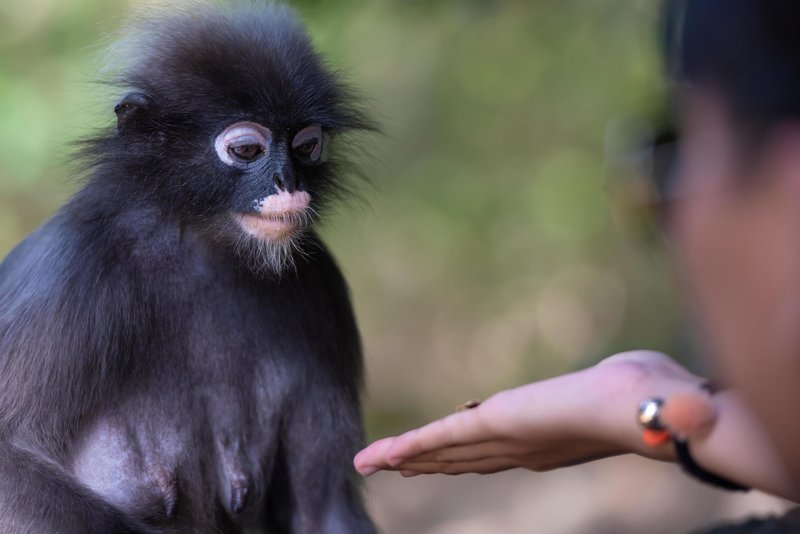
Langurs, specifically known for their striking features and social behavior, are often found in various parts of Asia. They’ve captivated not just scientists and wildlife enthusiasts but also storytellers, artists, and spiritual thinkers. Understanding how langurs are woven into the fabric of culture and folklore gives us a glimpse into the human experience, illustrating our need to connect with the world around us. Let’s dive deeper into the myriad ways the langur has been represented throughout history, from ancient stories to modern-day expressions.
1. Langurs in Indian Mythology
In India, langurs are more than just animals; they hold a significant place in mythology. One of the most famous references is in the *Ramayana*, an ancient epic. Hanuman, a revered figure, is often depicted with features resembling a langur. He’s not only a divine monkey god but also symbolizes strength, devotion, and intellect. This connection makes the langur a representation of loyalty and bravery.
These stories often emphasize the langur’s cleverness. For instance, tales describe how Hanuman outsmarts his enemies and helps his allies in times of need. This is similar to how we might view clever individuals in our societies today—those who use their wit to overcome challenges. When you see a langur, you might remember Hanuman’s wisdom, showcasing how folklore shapes our understanding of these creatures.
2. Langurs in Folk Stories and Proverbial Wisdom
Many cultures treasure tales featuring langurs, often portraying them as tricksters. In folk stories, they’re frequently caught in funny situations, teaching valuable lessons through their antics. For example, a common story involves a langur outsmarting a farmer intent on catching him. This theme of the “clever animal” is universal, seen in various cultures worldwide.
These stories serve a dual purpose: they entertain, but they also impart wisdom. Just as we might use proverbs to convey life lessons, the mischievous langur embodies the idea that sometimes, wit can win over brawn. When you tell children these stories, you not only entertain them but also instill values like intelligence, resourcefulness, and resilience. The langur becomes a mirror for the qualities we value in ourselves.
3. Symbolism in Art and Literature
Art has a unique way of capturing the essence of a subject. Langurs have inspired countless artists, appearing in paintings, sculptures, and literature. In traditional Indian art, you often find beautifully detailed representations of langurs, sometimes alongside deities, signifying their sacred status.
In literature, authors use langurs to symbolize various human traits. You might see them representing freedom, as they leap gracefully from tree to tree, or communal living, often seen in their social structures. Artists and writers tap into the qualities of langurs that resonate with us: curiosity, playfulness, and a deep connection to nature. Honestly, when you think about it, isn’t that how we often see ourselves in the animal world?
4. The Langur as a Spiritual Figure
Beyond tales and art, langurs often play a role in spirituality. In various cultures, they’re considered sacred animals, embodying different aspects of the divine. For instance, in Hinduism, they are seen as messengers of the gods, often linked to the protection of sacred spaces.
Visiting temples in India, you might find langurs roaming freely, treated with reverence and respect. Their presence in spiritual practices often serves to remind us of the interconnectedness of all living beings. When you engage with a langur, you’re not just observing an animal; you’re connecting with a deeper layer of cultural and spiritual symbolism. It makes you wonder how animals reflect our beliefs and ethics, right?
5. Langurs in Modern Popular Culture
Fast forward to modern times, and langurs still capture our imagination. They’ve made appearances in movies, documentaries, and even social media, highlighting their playful demeanor and importance in biodiversity. This resurgence in interest helps raise awareness about their habitats and the environmental challenges they face.
In popular culture, langurs often symbolize balance and harmony with nature. You might notice how they’re portrayed in conservation campaigns, showcasing the need to protect their environments. By engaging with stories through films and online content, we can foster a better understanding of these creatures and their roles in our ecosystem. It’s like seeing our own responsibilities reflected in their adorable faces!
6. Conservation Efforts and Their Cultural Relevance
As awareness grows about the importance of conservation, langurs are often at the forefront. Their depiction in culture underscores the urgency of protecting not just them, but their ecosystems as well. From community-driven conservation projects to global awareness campaigns, every effort highlights the cultural significance of langurs.
It’s crucial to remember that culture and conservation go hand in hand. When communities value langurs through their folklore and traditions, they’re more likely to invest in their protection. This relationship emphasizes how cultural narratives can drive real-world change, making us reflect on our own roles in conservation.
7. The Langur in Global Context
While langurs are primarily associated with South Asia, their representation can be found in various cultures around the globe. The concept of the trickster appears in many mythologies, holding a mirror to human behavior and ethics. By drawing parallels between langurs and similar figures in other cultures, we can appreciate the universal themes that bind us all.
From the wisdom of the *Coyote* in Native American folklore to the clever antics of the *Fox* in European tales, the langur finds its place among other notable figures. This connection invites us to explore how different cultures understand the same themes through their unique lenses.
8. The Future of Langurs in Culture
As we look ahead, the representation of langurs in culture will likely evolve. With increasing awareness of wildlife conservation, their depiction may shift towards highlighting challenges faced by these creatures. A shift in narratives can inspire new legends, emphasizing the need for coexistence and respect for nature.
This evolution presents an opportunity for storytellers and artists alike. By weaving in themes of sustainability and ecological awareness, the langur can continue to symbolize our relationship with the natural world. Whether you’re a writer, artist, or simply a nature lover, it’s vital to reflect on how these narratives shape our perspectives and actions moving forward.
In conclusion, the langur isn’t just a creature swinging through the trees; it’s a symbol rich with meaning in our cultures and folklore. From ancient myths to modern storytelling, these animals represent wisdom, bravery, and resourcefulness. As we continue to explore their stories, we deepen our connection to nature and the vital role we play in protecting it. Understanding the langur’s place in our cultural fabric is a gentle reminder that every creature has a story worth telling.

